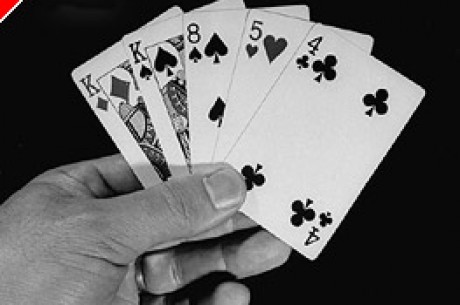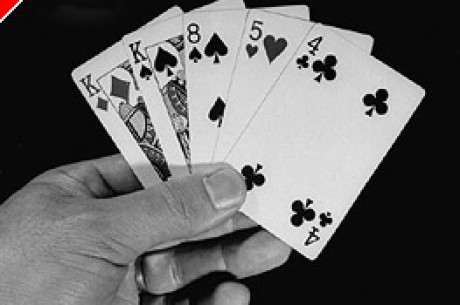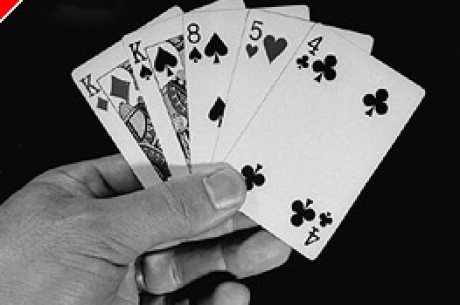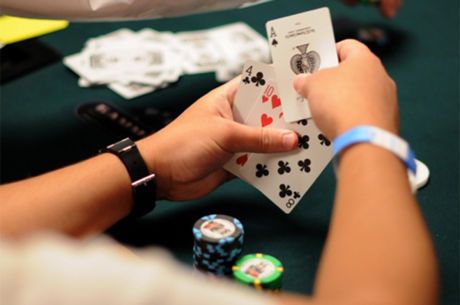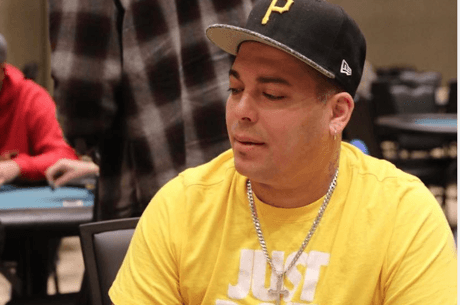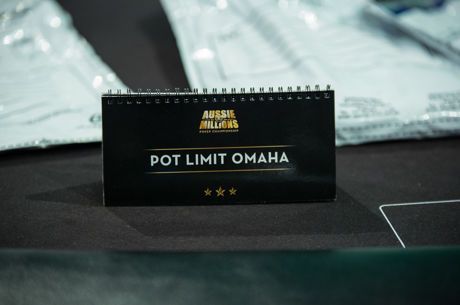Flopping A King High Flush in Omaha Hi-Lo

In Omaha hi-lo, I use a very 'specific' approach when I flop a king high flush. On the one hand, it can be highly profitable because you will never split the high end of a pot when you hold a flush. But on the other hand, there is the prospect of running into the ace-high flush - a danger more prominent in Omaha than in hold'em. As such, I have developed a rather systematic approach which addresses all the difficulties: maximizing profit (if you are in front), putting pressure on all the draws and finding out whether I'm up against an ace high flush as early as possible.
PREFLOP RAISE
In Omaha hi-lo, preflop raises generally come from three sorts of hands:
1) STRONG HIGH: A-A-(with two high cards)- for example A-A-K-J.
2) STRONG LOW: for example A-2-3-5 (usually suited one way)
3) STRONG MIX OF HIGH AND LOW POTENTIAL : A-A-K-2.
Therefore, I'm rather inclined to give up hands like Ks-Qs-2h-3c from a late position when I'm facing a raise. I need a lucky flop and even if I get one, it can be hard to defend. More to the point, few flops are really going to give me the nuts or a nut draw, so I'm more inclined to pass the "speculative" hands when facing a preflop raise.
If you already have a single preflop bet in there and you got caught by a late position raiser, your situation is not that great either. If it's a multi-way pot, I might call and hope for a long-shot flop or, at the very least, a nut low draw. But if it's short handed, I certainly don't want to take on a preflop raiser who has position on me.
ON THE FLOP
The flop is the key street when you have a king-high flush in Omaha hi-lo. So here are the basic 'rules' to follow:
a) YOU FLOPPED A FLUSH AND NO LOW DRAW IS PRESENT - For example, the flop is Qh-Jh-9h and you have Ad-Kh-4s-2h. In this spot, you MUST bet if it is checked to you. If there is a bet on the flop, raise right there and then. If you are re-raised, then you have significantly boiled down the situation: you opponent probably has the ace-high flush or has a ten high flush and a set. A kigh-high straight here would virtually never re-raise. While it depends on the opponent, most will usually call your raise if they have a set (including top set). I find it difficult to find reasons to continue playing my hand when re-raised on the flop, but I concede that on the odd occasion, I've thrown away the best hand. But even top flight players make this mistake every now and again. Finally, if I bet and I am raised, I will probably re-raise and see what sort of reaction I get. If it's capped, I'm out. If he calls my re-raise, I'll check the turn and if he bets into me again, I'm almost certain he's got the ace-high flush because he clearly doesn't fear a check-raise from me. Strange approach, but gives you all the information you need for the cost of a few bets on the flop.
b) YOU FLOPPED A FLUSH, A LOW DRAW IS PRESENT AND YOU HAVE NO LOW POTENTIAL - For example, the flop is Jh-8h-5h and you have Kh-Qs-10s-9h. In this case, you should generally follow the advice offered in part (a) with one important exception: you should not be as concerned about a re-raise because low draws can result in an over-abundance of action on the flop. In hi-lo there are players who will triple raise in this spot with hands like Ac-2d-3h-6h or As-2s-5c-5d, simply because they feel that they may have a 'scoop' and want to charge the low draws as much as possible. As a result, I'm not as reluctant to fold if the opponent is a loose and pushy player. But obviously, if the re-raiser would almost certainly have the nut high in this spot, I still may give it up.
c) YOU FLOPPED A FLUSH, A LOW DRAW IS PRESENT AND YOU HAVE LOW POTENTIAL - For example, the flop is Jh-8h-5h and you have Ad-Kh-Qs-3h. The advice offered in part (a) generally applies, but I would say that I would almost always call a re-raise with this type of hand. And if I had A-2 or a hand like Ac-2h-3s-Kh, I would cap the betting on the flop due to the scoop potential.
d) YOU FLOPPED A FLUSH, A LOW HAND IS POSSIBLE, BUT YOU DON'T HAVE A LOW OR LOW DRAW - For example: 8h-7h-4h and you have Kh-Qh-Js-10d. In this case, I am going to tread very very carefully. The main issue in this sort of pot is that you can get stuck between two people who are reraising each other endlessly; one has the ace-high flush and the other has the nut low. Therefore, if the pot is multi-way and the action is rather tense, I'm more or less "straight out of there." I hate being sandwiched in hi-lo with neither a nut high nor a nut low. If there is only aggressor and a number of callers, I will call the flop. If it is checked to me, I would still go ahead and bet it. I may even bet it if I'm the first to act, simply to try and work out what I'm up against. If the action is thick and fast behind me, I'll fold because I refuse to get stuck out of position.
e) YOU FLOPPED A FLUSH, A LOW HAND IS POSSIBLE AND YOU HAVE A LOW HAND - for example: 8h-7h-4h and you have Kh-Qh-Ac-3c. In this spot, I will bet. However, I will not usually raise because I'm conscious of the fact that I may end up getting scooped by two different opponents. But I usually call all the way to the showdown because I figure that either my high or my low will get half the pot. Obviously, if the action is very heavy, I'll probably take off another card, but I won't get stuck paying off lots of bets and raises on the turn.
If I have the nut low (A-2) and the second nut high, I'll take my chances and fire in as many bets as possible on the flop. On some occasions, you can trap a player who holds a hand like 2c-3c-9h-10h or you may trap two players, where one has A-2-x-x and the other has a queen high flush (in which case, you get three quarters of the pot - which is still a good outcome provided that the pot is large). But keep in mind that tight and sensible players don't usually over-pump the pot with a nut low and therefore, if one is relentlessly aggressive on the flop, I usually suspect that they have the ace-high flush and I'll slowdown considerably.
As a side note, a generally aggressive approach has a greater chance of forcing all the two-pairs out of the pot. They probably won't fold if it is a rainbow flop, but they will be more inclined to give it up easily on the flop is a flush is present because of two factors. First, they know that they probably have to improve to a full house to win. Second, they don't overlook the possibility of a caller or bettor having a set, meaning that they could improve to a full house and still lose. This is usually enough reason for them to fold and if you can achieve that, there are fewer repeats that will hurt you (ie... you will not always lose if the board pairs).
ON THE TURN
a) THERE IS NO LOW AND NO LOW DRAW - If you are certain that there will be no low, no matter what falls on the river that changes things. On the one hand, it gives you all the more reason to bet because you are not going to split the pot, therefore, you must maximize profits. On the other hand, it's very unlikely that anyone will raise you without the nuts. So to kill two birds with one stone, I will bet straight out and if I'm raised, I'm very reluctant to call, unless I know my opponent will try to pull a bluff with a hand like Ah-Jc-9s-8s (ie... naked ace of hearts). If there is a bet in front of you, it is a judgment call (if you'll forgive the pun). I certainly wouldn't start raising if I faced a bet. But then again, it is very difficult for me to say that this situation is an 'automatic fold' because someone may bet a mediocre flush and take their chances.
If you got into a raising war on the flop with an opponent and they raise you on the turn, that's probably as far as you can go with a king-high flush.
b) THERE IS NO LOW, BUT THERE IS A LOW DRAW - The answer to this scenario is simple: bet! If it is checked to you, bet straight out. While you risk being raised (or check raised) by an opponent who was slowplaying the ace-high, you simply cannot let people draw to lows for free. If an opponent has A-K-4-4 on a board of Jh-8h-7h, many will take off another card, but if the turn is a 10d and he faces a bet and callers (or potential callers) on the turn, they would probably fear that their low is no good if it hits - even if a 2 falls. As a result, putting pressure on this opponent on the turn will (hopefully) force them out. The interesting aspect is that, on some occasions, you will force out the only player or players with a low draw, simply because their low draw is seemingly too weak to call a turn bet with. Therefore, if a low card falls on the river, you still scoop because you were able to push them out of the turn. Furthermore, if a player has a legitimate low draw (for example Q-Q-A-2) and the river is a 2, they have nothing but you still collected a bet from them on the turn. All these angles may seem relatively 'small' or 'insignificant' but in the long run, they can greatly improve your winnings.
As a side-note, if you have the second nut flush and a strong low draw, you have all the more reason to bet, but if raised, it may still be worth calling and checking and calling on the river, even if you miss your low. You want to minimize your losses if you're behind, but you don't want to allow your opponents to know that they can run all over you on the river.
c) THE TURN COMPLETES POTENTIAL LOW DRAWS AND YOU DON'T HAVE A LOW - In this case, I will play it very gently. If it is checked to me, I will check as well. If someone bets, I will just call. If there is a raise (regardless of whether there is a bet and raise in front of me or whether I call a bet and then someone raises behind me) I'm much more apprehensive about my hand. On the one hand, I could be facing two nut lows and since my king-high flush is the best hand, the situation is optimal - suggesting that betting is virtually mandatory. On the other hand, I could be up against a nut low and a nut high, in which case, the situation is utterly disastrous - I should be checking and folding. However, this is where is pays to play better games (ie. where the players are fairly knowledgeable about the game) because, if a player has A-2-x-x on a board of Qh-8h-6h-5h and he is a 'good' player, he may not necessarily raise and re-raise endlessly because he realizes that he may end up with only a quarter of the pot, either because one opponent has a strong high and nut low or because two players have the nut low and one has the high. So his goal is getting to a showdown as cheaply as possible with the nut low and no high. As a result, you are less likely to be re-raised and sandwiched between a nut high and nut low in this type of game.
But the truth is that many Omaha hi-lo games contain very poor players who will raise and re-raise perpetually when they have the nut low, irrespective of their high. If that's the case, it's hard to say whether you should call or fold if you are facing a raise with a king-high flush and no low. I suppose it partly depends on who is betting and who is raising, but if I don't like this spot, irrespective of whether I technically have the best hand. To begin with, I am only now playing for half the pot, which certainly changes the cost-benefit aspect of the scenario. But moreover, I think that there are plenty of situations where you can feel more comfortable calling raises and re-raises in Omaha hi-lo and I general prefer to wait for them if the players are loose and trashy. Yet, if you have a good "feeling" that the bettor and raiser are more likely to be in there with a low rather than a high, perhaps calling is warranted.
d) THE TURN GIVES YOU A LOW: This is fairly straight-forward. If you have the nut low and second nut high, that's enough to open up and become very aggressive. If the turn only improves you to a reasonable low (eg... second or third best low), it's probably worth betting, but if raised, probably call and call the river too. Unfortunately, you have the second best of either end, so you are still in a position where you could get scooped. Caution is not uncalled for in this spot.
THE REPEAT RULE
If you have position on the field, the turn brings a repeat (board pairs) and it is checked to you again, a bet is virtually compulsory. The main reason is this: if a typical Omaha player has Q-Q-x-x on a flop of Qh-8h-7h, he will bet in position if it is checked to him, despite the fact that he may be up against a flush. Other players are usually conscious of this fact. Therefore, if you bet in position on the flop, the board pairs on the turn and they check to you again, a bet here is really putting them in a tough spot. They now suspect that you probably have the high end of the pot locked up and most probably won't take another card without a perfect low draw (eg - A-2).
There is a two-fold beauty to this play. First, if they have the ace high flush, your betting patterns suggest that you flopped a set and turned a full house. They do not indicate that you have a king-high flush and because of that, they will slowdown dramatically. As a result, they will probably call the turn but check to you on the river, allowing you to check behind them and showdown cheaply (thereby saving bets). Even if they have a hand like 8-7-x-x in the above example, there is still some chance that they will check and call the turn and check to you on the river. Either way, you get a showdown cheaply when your hand is vulnerable by fearlessly betting on the turn. Second, you kick out all those crappy low draws like 3-4 and 2-5 when you continue to bet the turn in this spot. As a result, your turn bet eliminates all low draws except for A-2 or A-3. If they make a low, so be it - the pot will be split. But if they pair one of their low draw cards (for example, if an ace falls on the river), the pot won't be split and you will scoop if you have the winner. However, if you check the turn and allow all the 2-3, 3-4, 5-2.... etc to draw for free, virtually any low card costs you half the pot if you have the best high hand.
As a side note, if someone bets into you on the turn or check-raises you, it's probably safe to throw your hand away, especially if there is no possible low. They, more often than not, have you beaten one way or the other. Wait for better opportunities.
THE RIVER
The river is rather cut and dried. If none of your opponents have raised and they all check to you on the river, it's probably safe to bet on most occasions. It's rare that an opponent with a nut flush will wait until the river and then attempt a checkraise. Even if a low is possible (and you don't have one), it may still be worth betting. If you have a good low (especially a nut low), I'd bet the river almost automatically, unless I'm certain that I'm up against a player who probably has the ace-high flush (in which case, I would simply check and call)
However, if I am out of position, I will simply check and call, provided that I have a good 'impression' that no one has the ace high flush (unless I have the nut low to go with my flush).
But there is one slightly tricky situation which can arise - when a player has been checking and calling the whole way and all of sudden, fires in a bet on the river. I'm not happy when a player does this, but I understand their motivation: in Omaha, they've have lost many times with nut flushes (cracked by full houses) in the past that they simply check and call all the way to river and if the board hasn't paired, they fire in a river bet with the nuts. Might seem a little strange, but some players have developed this bad habit and it is something you simply have to contend with... and the main reason why I hate calling the 'bet from nowhere' on the river, especially when the river card didn't appear to help anyone.
Ed note: Make many 'bets from nowhere' at Hollywood Poker

